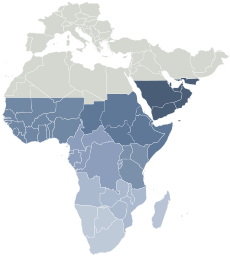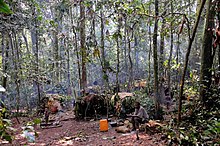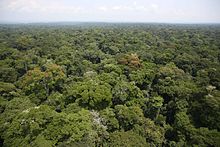Although tropical Africa is mostly familiar to the West for its rainforests, this ecozone of Africa is far more diverse. While the tropics are thought of as regions with warm to hot moist climates caused by latitude and the tropical rain belt, the geology
of areas, particularly mountain chains, and geographical relation to
continental and regional scale winds impact the overall parts of areas, also, making the tropics run from arid to humid in West Africa. The area has very serious overpopulation problems.
Overview
Tropical rainforests
are tropical moist forests of semi-deciduous varieties distributed
across nine West African countries. Institute for Sea Research conducted
a temperature record dating back to 700,000 years ago. Several conservation and development demographic
settings are such that the most loss of rain forests has occurred in
countries of higher population growth. Lack of dependable data and
survey information in some countries has made the account of areas of
unbroken forest and/or under land use change and their relation to
economic indicators difficult to ascertain. Hence, the amount and rate
of deforestation in Africa are less known than other regions of tropics.
The term deforestation refers to the complete obstruction of forest canopy
cover for means of agriculture, plantations, cattle-ranching, and other
non-forest fields. Other forest use changes for example are forest
disintegration (changing the spatial continuity and creating a mosaic of
forest blocks and other land cover types), and dreadful conditions
(selective logging of woody species for profitable purposes that affects
the forest subfloor and the biodiversity).
The general meaning to the term deforestation is linked not only to the
value system but the type of measurement designed to assess it. Thus,
the same interpretations of deforestation cause noticeable changes in
the estimate of forests cleared.
One reason for forest depletion is to grow cash crops. Nine West
African countries depend on cash crop exports. Products like gum, copal, rubber, cola nuts, and palm oil
provide rather steady income revenue for the West African countries.
Land use change spoils entire habitats with the forests. Converting
forests into timber is another cause of deforestation. Over decades, the
primary forest product was commercial timber.
Urbanized countries account for a great percentage of the world's wood
consumption, that increased greatly between 1950 and 1980.
Simultaneously, preservation measures were reinforced to protect
European and American forests.
Economic growth and growing environmental protection in industrialized
European countries made request for tropical hardwood become strong in
West Africa. In the first half of the 1980s, an annual forest loss of
7,200 km2 (2,800 sq mi) was note down along the Gulf of Guinea, a figure equivalent to 4-5 per cent of the total remaining rain forest area.
By 1985, 72% of West Africa's rainforests had been transformed into
fallow lands and an additional 9% had been opened up by timber
exploitation.
Tropical timber became a viable choice to European wood following
World War II, as trade with East European countries stop and timber
noticeably became sparse in western and southern Europe. Despite efforts
to promote lesser known timber species use, the market continued to
focus on part of the usable timber obtainable. West Africa was prone to
selective harvesting practices; while conservationists blamed the timber
industry and the farmers for felling trees, others believe rain forest
destruction is connected to the problem of fuel wood.
The contribution of fuel wood consumption to tree stock decline in
Africa is believed to be significant. It is generally believed that firewood provides 75% of the energy used in sub-Sahara Africa. With the high demand, the consumption of wood for fuel exceeds the renewal of forest cover.
African Pygmies living in the Dzanga-Sangha Special Reserve
The rain forests which remain in West Africa now merely are how they
were hardly 30 years ago. In Guinea, Liberia and the Ivory Coast, there
is almost no primary forest cover left unscathed; in Ghana the situation
is much worse, and nearly all the rain forest are cut down. Guinea-Bissau loses 200 to 350 km2 (77 to 135 sq mi) of forest yearly, Senegal 500 km2 (190 sq mi) of wooded savanna, and Nigeria 6,000,050,000 of both. Liberia exploits 800 km2 (310 sq mi) of forests each year.
Extrapolating from present rates of loss, botanist
Peter Raven pictures that the majority of the world's moderate and
smaller rain forests (such as in Africa) could be ruined in forty years.
Tropical Africa is about 18% of the world total covering 20 million km2 (7.7 million sq mi) of land in West and Central Africa.
The region has been facing deforestation in various degrees of
intensity throughout the recent decades. The actual rate of
deforestation varies from one country to another and accurate data does
not exist yet. Recent estimates show that the annual pace of
deforestation in the region can vary from 150 km2 (58 sq mi) in Gabon to 2,900 km2 (1,100 sq mi) in Cote d'Ivoire. Remaining tropical forest still cover major areas in Central Africa but are abridged by patches in West Africa.
The African Timber Organization
member countries (ATO) eventually recognized the cooperation between
rural people and their forest environment. Customary law gives residents
the right to use trees for firewood, fell trees for construction, and
collect of forest products and rights for hunting or fishing and grazing
or clearing of forests for maintenance agriculture. Other areas are
called "protected forests", which means that uncontrolled clearings and
unauthorized logging are forbidden. After World War II,
commercial exploitation increased until no West African forestry
department was able of making the law. By comparison with rain forests
in other places of the world in 1973, Africa showed the greatest
infringement though in total volume means, African timber production
accounted just one third compared to that of Asia. The difference was due to the variety of trees in Africa forests and the demand for specific wood types in Europe.
Forestry
regulations in east Africa were first applied by colonial governments,
but they were not strict enough to fill forest exploitation. It wasn't
until the 1970s that the inadequate performance of forest regulations
was recognized. The Tropical Forestry Action Plan was conceived in 1987
by the World Resources Institute in cooperation with the Food and Agriculture Organization, the United Nations Development Program (UNDP) and the World Bank with hopes of halting tropical forest destruction.
In its bid to stress forest conservation and development, the World
Bank provided $111,103 million in building countries, especially in
Africa, to help in developing long range forest conservation and
management programs meant for ending deforestation.
Region protection
Many
African countries are in economic and political change, overwhelmed by
conflict, making various movements of forest exploitation to maintained
forest management and production more and more complicated.
Forest legislation of ATO member countries aim to promote the
balanced utilization of the forest domain and of wildlife and fishery in
order to increase the input of the forest sector to the economic,
social, cultural and scientific development of the country.
Habitats
The
tropical environment is rich in terms of biodiversity. Tropical African
forest is 18 percent of the world total and covers over 3.6 million
square kilometers of land in West, East and Central Africa. This total
area can be subdivided to 2.69 million square kilometers (74%) in
Central Africa, 680,000 square kilometers (19%) in West Africa, and
250,000 square kilometers (7%) in East Africa.[2] In West Africa,
a chain of rain forests up to 350 km long extends from the eastern
border of Sierra Leone all the way to Ghana. In Ghana the forest zone
gradually dispels near the Volta river, following a 300 km stretch of Dahomey
savanna gap. The rain forest of West Africa continues from east of
Benin through southern Nigeria and officially ends at the border of Cameroon along the Sanaga river.
Semi-deciduous rainforests in West Africa began at the fringed
coastline of Guinea Bissau (via Guinea) and run all the way through the
coasts of Sierra Leone, Liberia, Ivory Coast, Ghana, continuing through Togo, Benin, Nigeria and Cameroon, and ending at the Congo Basin.
Rain forests such as these are the richest, oldest, most prolific, and
most complex systems on earth, are dying, and in turn are upsetting the
delicate ecological balance. This may disturb global hydrological
cycles, release vast amounts of greenhouse gases into the atmosphere,
and lessen the planet's ability to store excess carbon.
The rain forest vegetation of the Guinea-Congolian transition area, extending from Senegal to western Uganda
are constituted of two main types: The semi-deciduous rain forest
characterized by a large number of trees whose leaves are left during
dry season. It appears in areas where the dry period (rainfall below
about 100 mm) reach three months. Then, the evergreen or the
semi-evergreen rain forest, climatically adapted to somewhat more humid
conditions than the semi-deciduous type and is usually there in areas
where the dry period is shorter than two months. This forest is usually
richer in legumes and variety of species and its maximum development is around the Bight of Biafra, from Eastern Nigeria to Gabon, and with some large patches leaning to the west from Ghana to Liberia and to the east of Zaïre-Congo basin.
Judging against rain forest areas in other continents, most of
the African rainforest is rather dry and receives between 1600 and
2000 mm of rainfall per year. Areas receiving more rain than this mainly
are in coastal areas. The circulation of rainfall throughout the year
remains less than other rain forest regions in the world. The average
monthly rainfall in nearly the whole region remains under 100 mm
throughout the year. The variety of the African rain forest flora is
also less than the other rain forests. This lack of flora has been
credited to several reasons such as the gradual infertility since the Miocene, severe dry periods during Quaternary, or the refuge theory of the cool and dry climate of tropical Africa during the last severe ice age of about 18000 years ago.
A recent vegetation map of Africa published by UNESCO
and the main vegetation features of Central African rain forest divides
the area into the following categories:
. This type of forest shows no substantial seasonal behavior. At the
border of the central basin is the mesophilous semi-deciduous forest
that is mixed with deciduous and evergreen trees in the upper-stratum,
unusual age distribution, continuous shrub stratum at the lower canopy,
and a more marked seasonality.
Secondary forests
Beyond the forest reserves, a great deal of the remaining part of Central African
rain forest on well drained soils are old secondary forests. There also
exist younger secondary forests dominated by parasol trees, Musanga
cecropioides, the most abundant and characteristic secondary forest in
Africa. Such trees are found in upper layers of secondary growth along
the old road networks in Zaïre . The dispersal of secondary forests are
important in regional study as they show different floristic and
faunistic characteristics than primary forests, and represent centers of
human activity and history of land-use changes.
Non-forest
The
nart comprises degraded lands, irregular agriculture and plantations.,
and deforested lands and fragmented forests. Plantations have a
geometrical lay-out with uniform canopy-cover and follow a different vegetation
cycle as their adjacent features. The areas are located near the
transportation networks and are subjugated by economic tree crops such
as cacao, rubber, oil palms and Kola.
Swamp and flooded forests
Swamp forest, inundated forests in flood plains, and riparian forests are found here. Swamp forests are found widely in the Zaïre
basin and throughout the Congo basin where conditions are appropriate.
In most areas, swamp forests is like in appearance to rain forest and
the tallest trees attain a height of 45 m. The main canopy is often
irregular and open, sometimes resembling the secondary forests caused by
disturbance The forest has a variety in endemic flora
but it is inadequate in species. Recently, large areas of swamp forests
have been cleared for rice farming. Swamp forests in Zaïre, Congo and
other lowland forests have seasonal variations that to the level of
forest inundation.
Conservation
In
colonial rule, governments planned only one way to promote
conservation. In Nigeria for example, the government introduced forest
protection regulatory measures by classification of some forest areas,
licensing requirements, and the apprehension and prosecution of
offenders. Ghana issued classification permits to firms and executed log
export restrictions. The Ivory Coast and Cameroon introduced log supply
quotas, as Liberia did.
This trade product is "raw" lumber. Trees native to the West
African rainforest from which timber is exported include limba, emeri,
obeche and opepe as well as the exotic species gmelina, teak, and pinus.
Fauna
The Tropical African rainforest has rich fauna,
commonly smaller mammal species rarely seen by humans. New species
continually are being found. For instance, in late 1988 an unknown shrub
species was discovered on the shores of the Median River in Western
Cameroon. Since then many species have become extinct. However,
undisturbed rainforests are some of the richest habitats of animal
species. Today, undisturbed rainforests are remnant, but rare. Timber
extraction not only changes the edifice of the forest, it affects the
tree species spectrum by removing economically important species and
terminates other species in the process. The species that compose
African rainforests are of different evolutionary ages because of the
contraction and expansion of the rainforest in response to global
climatic fluctuations. In Tropical Africa about 8,500 plant species have been noted and 403 species of orchids note down. The pygmy hippopotamus, the giant forest hog, the water chevrotain and a number of insectivores,
rodents and bats, tree frogs, bird species inhabit the area. These
species, along with a diversity of fruits and insects, make a special
habitat. Top canopy monkey species, the red colobus, and others, already have disappeared from much of Tropical Africa's forest.
Species unfamiliar to the changes in forest structure for industrial use might not survive.
If timber use continues and an increasing amount of farming occurs, it
could lead to the mass killing of animal species. The home of nearly
half of the world's animals and plant species are tropical rainforests.
The rain forests provide possible economic resource for over-populated
developing countries. Despite the stated need to save the West African
forests, there are divergence in how to work. In April 1992, countries
with some of the largest surviving tropical rain forests banned a
rainforest protection plan proposed by the British government. It aimed
at finding endangered species of tropical trees in order to control
trade in them. Experts estimate that the rainforest of West Africa, at
the present trend of deforestation, may disappear by the year 2020.
Africa's rainforest, like many others emergent in the world, has a special significance to the indigenous cultures who have occupied them for millennia.
Recent news: History of Tropical Africa
In
early 2007, scientists created an entirely new proxy to determine
annual mean air temperature on land—based on molecules from the cell
membrane of soil inhabiting bacteria. Recently, Scientists from the
NIOZ, Royal Netherlands Institute for Sea Research conducted a temperature record dating back to 25,000 years ago.
In concord with the German colleague of the University of Bremen,
this detailed record shows the history of land temperatures based on
the molecular fossils of soil bacteria. When applying this to the
outflow core of the Congo River,
the core contained eroded land material and microfossils from marine
algae. That concluded that the land environment of tropical Africa was
cooled more than the bordering Atlantic Ocean during the last ice-age.
Since the Congo River drains a large part of tropical central Africa,
the land derived material gives an integrated signal for a very large
area. These findings further enlighten in natural disparities in climate
and the possible costs of a warming earth on precipitation in central
Africa.
Scientists discovered a way to measure sea temperature—based on
organic molecules from algae growing off the surface layer of the Ocean.
These organisms acclimatize the molecular composition of their cell
membranes to ambient temperature to sustain regular physiological
properties. If such molecules sink to the sea floor and are buried in
sediments where oxygen
does not go through, they can be preserved for thousands of years. The
ratios between the different molecules from the algal cell membrane can
approximate the past temperature of the sea surface. The new “proxy”
used in this sediment core obtained both a continental and a sea surface
temperature record. In comparison, both records shows that ocean
surface and land temperatures behaved differently during the past 25,000
years. During the last ice age, African temperatures were 21 °C, about
4 °C lower than today, while the tropical Atlantic Ocean
was only about 2.5 °C cooler. Lead author Johan Weijers and his
colleagues arrived that the land-sea temperature difference has by far
the largest influence on continental rainfall. The relation of air
pressure to temperature strongly determines this factor. During the last ice age, the land climate in tropical Africa was drier than it is now, whereas it favors the growth of a lush rainforest.





